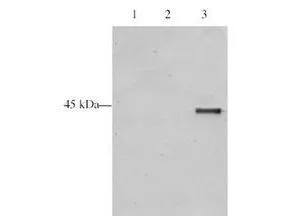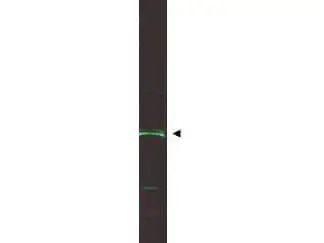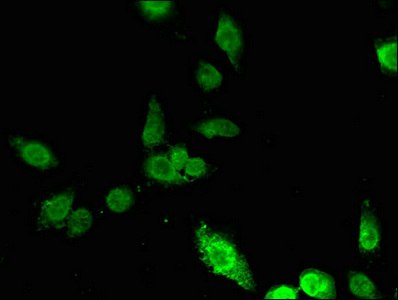![Western blot analysis is shown using GeneTexs Affinity Purified anti-p28 ING5 antibody to detect over expressed Human ING5 present in cell extracts. This western blot shows reactivity with purified recombinant human ING5 protein. Comparison to a molecular weight marker (not shown) indicates a single band of ~36 kDa corresponding to the expected molecular weight for the recombinant protein. Approximately 10 microg of lysate was separated on a 4-20% Tris-Glycine gel by SDS-PAGE and transferred onto nitrocellulose. After blocking the membrane was probed with the primary antibody diluted to 1:1,500.Incubation was overnight at 4o C followed by washes and reaction with a 1:20,000 dilution of IRDye?800 conjugated Rb-a-Goat IgG [H&L] MXHu for 45 min at room temperature. IRDye?800 fluorescence image was captured using the OdysseyR Infrared Imaging System developed by LI-COR. IRDye is a trademark of LI-COR, Inc. Other detection systems will yield similar results. Western blot analysis is shown using GeneTexs Affinity Purified anti-p28 ING5 antibody to detect over expressed Human ING5 present in cell extracts. This western blot shows reactivity with purified recombinant human ING5 protein. Comparison to a molecular weight marker (not shown) indicates a single band of ~36 kDa corresponding to the expected molecular weight for the recombinant protein. Approximately 10 microg of lysate was separated on a 4-20% Tris-Glycine gel by SDS-PAGE and transferred onto nitrocellulose. After blocking the membrane was probed with the primary antibody diluted to 1:1,500.Incubation was overnight at 4o C followed by washes and reaction with a 1:20,000 dilution of IRDye?800 conjugated Rb-a-Goat IgG [H&L] MXHu for 45 min at room temperature. IRDye?800 fluorescence image was captured using the OdysseyR Infrared Imaging System developed by LI-COR. IRDye is a trademark of LI-COR, Inc. Other detection systems will yield similar results.](https://www.genetex.com/upload/website/prouct_img/normal/GTX48484/GTX48484_20160330_WB_1_w_23060823_253.webp)
Western blot analysis is shown using GeneTexs Affinity Purified anti-p28 ING5 antibody to detect over expressed Human ING5 present in cell extracts. This western blot shows reactivity with purified recombinant human ING5 protein. Comparison to a molecular weight marker (not shown) indicates a single band of ~36 kDa corresponding to the expected molecular weight for the recombinant protein. Approximately 10 microg of lysate was separated on a 4-20% Tris-Glycine gel by SDS-PAGE and transferred onto nitrocellulose. After blocking the membrane was probed with the primary antibody diluted to 1:1,500.Incubation was overnight at 4o C followed by washes and reaction with a 1:20,000 dilution of IRDye?800 conjugated Rb-a-Goat IgG [H&L] MXHu for 45 min at room temperature. IRDye?800 fluorescence image was captured using the OdysseyR Infrared Imaging System developed by LI-COR. IRDye is a trademark of LI-COR, Inc. Other detection systems will yield similar results.
ING5 antibody
GTX48484
Overview
- SupplierGeneTex
- Product NameING5 antibody
- Delivery Days Customer9
- Application Supplier NoteWB: 1:500-1:1000. ELISA: 1:4000-1:16000. *Optimal dilutions/concentrations should be determined by the researcher.Not tested in other applications.
- ApplicationsWestern Blot, ELISA
- CertificationResearch Use Only
- ClonalityPolyclonal
- Concentration1.52 mg/ml
- ConjugateUnconjugated
- Gene ID84289
- Target nameING5
- Target descriptioninhibitor of growth family member 5
- Target synonymsinhibitor of growth protein 5; p28ING5
- HostGoat
- IsotypeIgG
- Protein IDQ8WYH8
- Protein NameInhibitor of growth protein 5
- Scientific Descriptionp28 ING5 is a tumor suppressor protein similar to ING1 that can interact with TP53, inhibit cell growth, and induce apoptosis. This protein contains a PHD-finger, which is a common motif in proteins involved in chromatin remodeling. This protein can bind TP53 and EP300/p300, a component of the histone acetyl transferase complex, suggesting its involvement in TP53-dependent regulatory pathway. Multiple alternatively spliced transcript variants have been observed.
- Storage Instruction-20°C or -80°C,2°C to 8°C
- UNSPSC12352203








